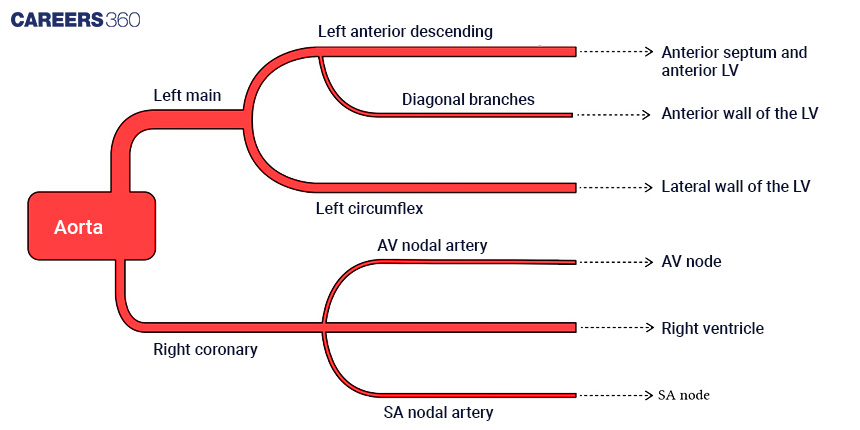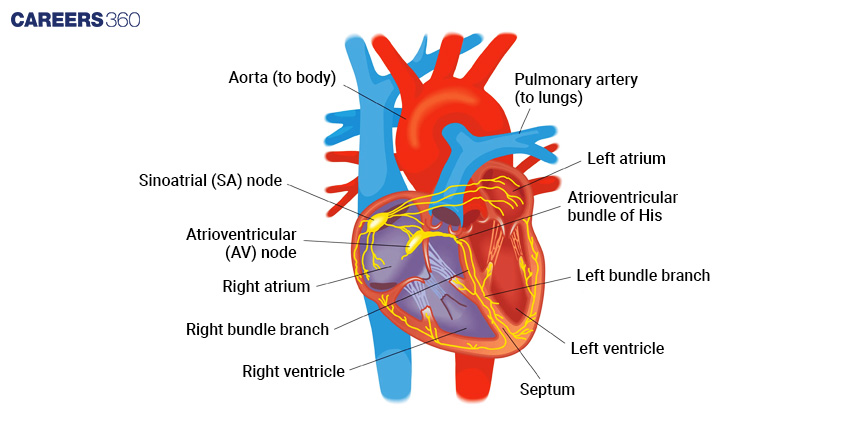Coronary Circulation: Definition, Process, Diagram, Flow Chart
What Is Coronary Circulation?
Coronary circulation refers to the blood flow through coronary arteries and veins that supply oxygen and nourishment to the myocardium, that is, the heart muscle. The coronary arteries arise directly from the aorta and provide oxygenated blood to the myocardium, while the coronary veins collect deoxygenated blood, whereby it gets all the elements to function properly for the sustenance of life.
Anatomy Of The Coronary Circulation
Understanding the anatomy of coronary circulation is important in appreciating the way that the heart maintains its blood supply. This section shall consider the anatomy of the heart, including the coronary arteries and veins.

Anatomy Of The Heart
The heart is a muscular organ that pumps blood throughout the body. It contains four chambers: two atria and two ventricles.
Coronary Arteries Left And Right Coronary Arteries
Left Main Coronary Artery [LMCA]: The blood supply is provided to the left side of the heart.
Left Anterior Descending Artery [LAD]: It comes as the side branch of the LMCA, passing towards the front portion of the heart.
Left Circumflex Artery [LCA]: It also goes as a side branch from the LMCA, giving supply to the side and the back portions of the heart.
Right Coronary Artery (RCA): Blood supply to the right side of the heart.
Coronary Veins
Great Cardiac Vein: Blood drainage from the front portion of the heart
Middle Cardiac Vein: Blood drainage from the back portion of the heart.
Small Cardiac Vein: Blood drainage from the inferior portion of the heart.
Coronary Sinus: It is a large vessel that drains blood from the coronary veins and empties it into the right atrium.
Physiology Of Coronary Circulation

This section identifies how blood flows through the coronary circulation system to ensure appropriate oxygenation of heart muscle plus the necessary nutrition.
Blood Flow Dynamics
Blood flow to the coronary happens in the relaxation phase of the heart, and it provides oxygen-rich blood to the heart muscle.
Myocardial Perfusion And Oxygen Supply
Myocardial perfusion is the delivery of blood toward the tissue of the heart that ought to be enough to supply adequate oxygen to meet the metabolic needs of the heart.
Regulation Of Coronary Blood Flow
The heart can change blood flow based on its needs.
Neural and Hormonal Control: The change in the blood flow of the coronary through the nervous and hormonal systems.
Coronary Arteries And Their Functions
Describe each of the coronary arteries, including their function and what part of the heart muscle they provide blood flow to.
Left Main Coronary Artery (LMCA)
It supplies blood to the left atrium and the left ventricle.
Left Anterior Descending Artery(LADA)
Blood supply is directed towards the front and bottom of the left ventricle and to the front of the septum.
Left Circumflex Artery (LCA)
Supplies blood to the outer side and back of the left ventricle.
Right Coronary Artery (RCA)
It provides blood to the right atrium, the right ventricle, the lower part of both ventricles and the back of the septum.
Coronary Veins And Their Functions
This section talks about the details of all coronary veins and their functions in collecting oxygen-depleted blood from the cardiac muscle.
Great Cardiac Vein
It drains blood from the front or anterior part of the heart.
The Middle Cardiac Vein
Drains blood from the back of the heart.
Small Cardiac Vein
It drains blood from the lower portion of the heart.
Coronary Sinus
Collects blood from the coronary veins emptying it into the right atrium.
Common Disorders Of Coronary Circulation
This unit shall review some of the common disorders that affect coronary circulation, its causes, symptoms, and treatment options.
Coronary Artery Disease (CAD)
Definition and Causes: CAD occurs when plaque builds up and the coronary arteries are narrowed or occluded.
Symptoms and Risk Factors: The patient will feel chest pain with shortness of breath; other risk factors include smoking, high blood pressure, and a high count of cholesterol.
Prevention and Treatment: Changes to the lifestyle, medication, and even surgical procedures such as angioplasty.
Myocardial Infarction (Heart Attack)
Definition and Causes: A heart attack essentially refers to the clogging or blockage of the blood flow to parts of the heart.
Symptoms and Emergency Response: One would be having discomfort in the chest, shortness of breath, and nausea. One should call for medical help immediately.
Treatment and Recovery: Medications are involved along with lifestyle changes and surgical interventions.
Angina Pectoris
Definition and Classification: Angina refers to chest pain, typically caused by a reduction in blood flow towards the heart. The most common forms of angina are stable and unstable angina.
Symptoms and Treatment: These vary from chest pain to discomfort. Its treatment comprises drugs and changes in lifestyle.
Diagnosis Techniques For Disorders In Blood Supply To The Coronaries
The section sets out the various techniques used in diagnosing coronary circulation problems.
Electrocardiogram (ECG)
This measures the electrical activity of the heart and detects any irregularities therein.
Stress Tests
The way the heart works during physical stress is assessed.
Coronary Angiography
Dye is used, which is visible by X-ray, to show up the coronary arteries.
Cardiac MRI And CT Scans
Detailed pictures of the structure and function of the heart are obtained.
Treatment And Management Options For Disorders Of Coronary Circulation
The treatment and management options include:
Lifestyle Changes And Prevention Strategies
A healthy diet and regular exercise, with avoidance of smoking.
Medications
Anti-anginal drugs: Relieve chest pain.
Blood Thinning agents: Prevent blood clots from forming.
Cholesterol-reducing drugs: Prevent plaque deposition.
Surgical Interventions
Angioplasty: Unblocks the blocked arteries surgically
Stent placement: This opens up blocked arteries.
Coronary Artery Bypass Grafting (CABG): By-passes obstructed arteries.
Recent Advances In Coronary Circulation Research
This section deals with the recent advances made in coronary circulation research in the form of new diagnostic techniques or newer modalities of treatment.
Advances In Diagnostic Techniques
Better diagnostic tools using improved techniques of imaging.
New Modalities Of Treatment
Newer treatments for coronary artery disease.
New Therapies
Future therapies will help in the enhancement of coronary circulation.
Conclusion
This section summarises and reiterates the key take-home messages arising from the article about how one of the most important fundamental mechanisms by which a healthy heart stays healthy is through the maintenance of healthy blood flow to the coronary circulation. Herein, future directions of research into coronary circulation are also reviewed.
Recommended video on Coronary Circulation
Frequently Asked Questions (FAQs)
It is diagnosed by electrocardiogram, stress tests, coronary angiography, cardiac MRI, or CT scans.
The lifestyle changes include a heart-healthy diet, regular exercise, Smoking cessation, and Stress management.
Know how the coronary arteries supply oxygen-rich blood to the heart muscle—the myocardium—so that it can effectively perform its work.
It can be reduced by proper dieting with healthy food, frequent exercise, avoiding smoking, and keeping control over mental stress.
Chest pain, shortness of breath, nausea, sweating. These are typical symptoms of a heart attack.